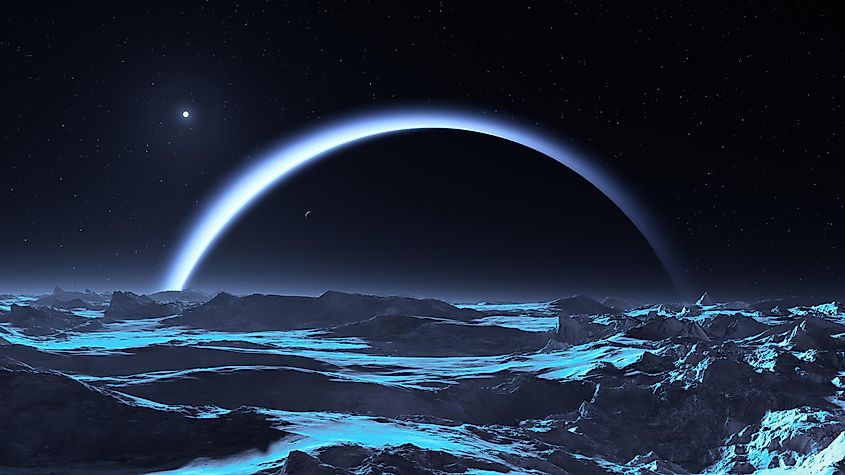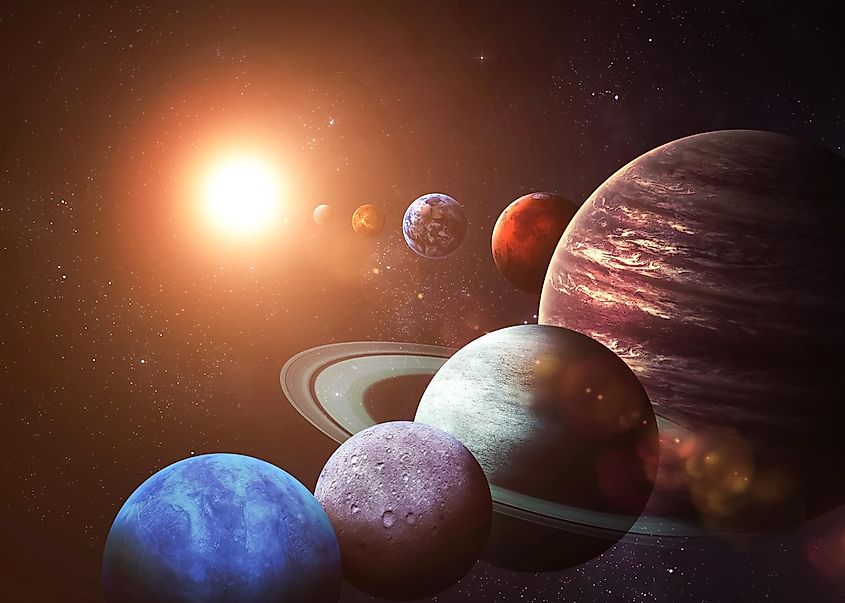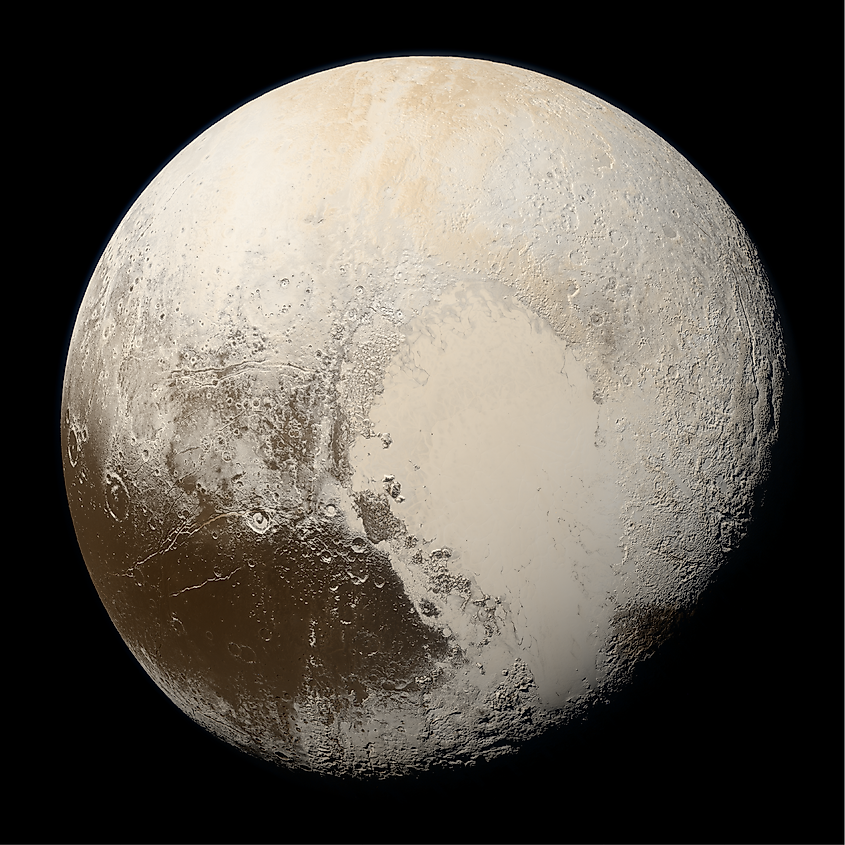For most of human history, we could only see six planets: Mercury, Venus, Earth, Mars, Jupiter, and Saturn. The two outermost planets, Uranus and Neptune, were too far for early civilizations to see without a telescope. Uranus was the first planet to be discovered using a telescope. In 1781, the astronomer William Herschel discovered Uranus using a telescope. The discovery of Uranus inevitably led to the discovery of Neptune. The orbit of Uranus was complicated for astronomers to explain, and there were slight changes in it that could not be explained given the mass of Uranus and the other gas giants. To explain Uranus’s orbit, astronomers predicted the existence of another planet that orbited the Sun beyond Uranus. Neptune was first observed in 1846, confirming earlier predictions of its existence. This makes Neptune the only planet to be discovered using mathematics. With Uranus and Neptune, the solar system grew to include eight planets. However, the story wasn’t over.
The Ninth Planet

Like Uranus, the orbit of Neptune was slightly irregular. Given the calculated masses of Neptune and the other gas giants, the rotation of Neptune made little sense. Astronomers predicted that another planet must exist beyond the orbit of Neptune. For decades, astronomers surveyed the night sky searching for the ninth planet. Then, in 1930, astronomer Clyde Tombaugh discovered what was believed to be the ninth planet. Not only was it far beyond Neptune, but it was also very close to the predicted position of the ninth planet. It was called Pluto, and once again, the solar system’s family of planets grew. However, Pluto’s story was far from over. As it would later turn out, Pluto was far too small to explain the irregularities in Neptune’s orbit. Instead, Pluto may have been considered a planet, but its discovery was complete luck. When the Voyager 2 spacecraft completed its flyby of Neptune in 1989, it was revealed that the mass of Neptune was different from what astronomers had calculated. Once the correct mass of Neptune was accounted for, its orbit no longer contained irregularities. Despite this, Pluto would still be considered a planet until it was redefined as a dwarf planet in 2006. For the first time, the number of planets in the solar system shrunk.
Has The Solar System Always Had Eight Planets?

Today, the solar system contains eight planets. However, this has not always been the case. Shortly after the Sun formed and the planets began forming, a hundred or more planets were likely forming around the Sun. The early solar system existed in a state of utter chaos. The gravitational pull of so many planets made it difficult for them to find stable orbits. Instead, planets tugged on one another and would sometimes cross orbits. Occasionally, entire planets would collide. Depending on the mass of the planets and the angle at which the collision occurred, the larger planet would either absorb the smaller planet, or they would both break apart. It is generally believed that every planet in the solar system underwent one or more collisions with other planets. Even the Earth experienced a planetary collision around 4.5-billion years ago. A Mars-sized planet called Theia collided with the Earth at just the right angle that, rather than the two planets breaking apart, the young Earth absorbed Theia, and the debris from the collision went on to form the Earth’s moon.
The Return Of Planet Nine

With Pluto’s demotion, many thought that the idea of a ninth planet in the solar system was dead. However, in the last decade, observational evidence has hinted at the existence of another planet far beyond the orbit of Neptune. In the far outer regions of the solar system, there exist countless comets, miklky w, and other forms of planetary debris in an area called the Kuiper Belt. While tracking the orbital path of some Kuiper Belt Objects (KBO), astronomers found some irregularities in their orbits. If a planet roughly 10-times the size of the Earth existed in the Kuiper Belt, it would explain the abnormalities observed in these orbits. If this hypothetical Planet Nine does exist, it will orbit the Sun roughly 400 times further than the Earth orbits the Sun. It would take Planet Nine thousands of years to complete one orbit around the Sun. As of yet, astronomers have found no definitive proof that Planet Nine exists.
It may seem strange that a planet within our solar system is hard to find. After all, scientists have uncovered thousands of planets outside the solar system, so why is it so difficult to find one within the solar system? Unfortunately for scientists, finding Planet Nine is no easy task if it even exists. Rather than being able to look inwards and use things like a star’s gravity or light to uncover a planet, scientists are looking outwards, trying to observe a planet that would receive virtually no sunlight. Planet Nine would also give off little to no heat, making it tremendously difficult to observe it in other wavelengths of light.
If there is a ninth planet in the solar system in the Kuiper Belt, it is unlikely it formed that far away from the Sun. Instead, it would have formed much closer and been pushed away by the other gas giants and planetary collisions. Perhaps a more intriguing hypothesis is that Planet Nine never actually formed in our solar system. It may have formed in a different solar system in the Milky Way, eventually being caught by the Sun’s gravity. This may seem strange, but a star can capture other planets. During the formation of a solar system, several planets may be flung outside their star’s gravity, becoming what are known as rogue planets. Some rogue planets may eventually find themselves close enough to another star to be captured by its gravity. The search for Planet Nine is ongoing, and if it does exist, its discovery will represent one of the most significant discoveries in the history of our solar system. As of yet, the solar system still contains eight planets.
https://news.google.com/__i/rss/rd/articles/CBMiVGh0dHBzOi8vd3d3LndvcmxkYXRsYXMuY29tL3NwYWNlL2hvdy1tYW55LXBsYW5ldHMtYXJlLXRoZXJlLWluLXRoZS1zb2xhci1zeXN0ZW0uaHRtbNIBWGh0dHBzOi8vd3d3LndvcmxkYXRsYXMuY29tL2FtcC9zcGFjZS9ob3ctbWFueS1wbGFuZXRzLWFyZS10aGVyZS1pbi10aGUtc29sYXItc3lzdGVtLmh0bWw?oc=5
2022-05-02 04:46:15Z
CBMiVGh0dHBzOi8vd3d3LndvcmxkYXRsYXMuY29tL3NwYWNlL2hvdy1tYW55LXBsYW5ldHMtYXJlLXRoZXJlLWluLXRoZS1zb2xhci1zeXN0ZW0uaHRtbNIBWGh0dHBzOi8vd3d3LndvcmxkYXRsYXMuY29tL2FtcC9zcGFjZS9ob3ctbWFueS1wbGFuZXRzLWFyZS10aGVyZS1pbi10aGUtc29sYXItc3lzdGVtLmh0bWw
Tidak ada komentar:
Posting Komentar